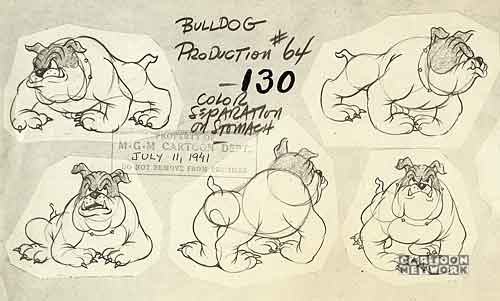What makes something cartoony?
Partly it's exaggerated proportions.
Here is your basic generic 1940s cartoon bulldog.
It's not very cartoony.

Why?
Because the proportions are too even.
The chest is big but not too big.
The butt is small but not too small.
His head is split evenly into 2 parts: the cranium and the jaw.
 Here's a Tex Avery bulldog and look how much more cartoony it is!
Here's a Tex Avery bulldog and look how much more cartoony it is!The basic construction is the same as the Hanna Barbera bulldog, but the contrasts in sizes of the shapes is much greater.
The chest is REALLY big.
The butt is REALLY small.
The chin is waaay bigger than the cranium.
The eyes are tiny.
The front legs are way bigger than the back legs.
CONTRASTS in proportions=exaggeration=cartoony=funny.
Got it?
*Interestingly, the only contrasts in this design are contrasts of size. The character is completely constructed of ovals. Varying the size contrasts alone makes it an appealing funny design.
 Here's another Tex Avery bulldog.
Here's another Tex Avery bulldog.This design has the same basic construction as the Tom and Jerry Bulldog, and the contrasts are slightly more exaggerated than the first bulldog but not as exaggerated as the first Tex Avery bulldog.
BUT! It has some other variations from the generic bulldog:
It's eyes are on angles-they are wider apart at the top than at the bottom.
The back legs are bowed apart, while the front legs are pigeon-toed.
His head is more triangular, with the point on top, rather than an evenly shaped oval.
So it has not only contrasts in sizes of forms, but also in shapes of forms and directions of forms.
So these variations on the basic evenly shaped and proportioned Hanna Barbera (I think it's Hanna Barbera) bulldog make it a particular design, whereas the Hanna Barbera mutt is merely generic.
Generic means even and inspecific. To qualify as a design, there has to be a set of specific variations on a basic set of forms.
Chuck Jones, Bob Clampett and Tex Avery are such big stars because they all have very specific styles and their cartoons make all kinds of specific statements and they constantly experimented.
This is why you can so readily recognize their cartoons as being theirs.
Most people in every field are generic types. They don't have individual statements to make.
Humans are naturally attracted to very individualistic people with charisma. Elvis, Frank Sinatra, The Beatles, Kirk Douglas, Joan Crawford, Humphrey Bogart and most stars of the past.
In the 1940s when Avery, Jones and Clampett really stood out from the rest of the animators, we also had very generic animators like Friz Freleng, Hanna Barbera, Harman and Ising and Walt Disney. They believed in "quality" of course, but were very conservative about style and statements.
Today, almost everything is generic - only it's generic without the skill and high standards of the 1940s.
GO SEE THE CARTOONS HERE!

